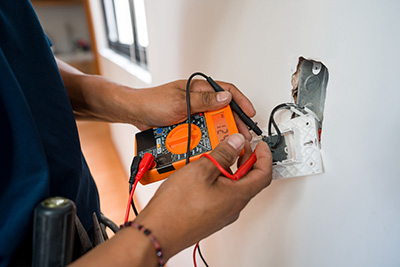Does a Surge Protector Protect Against Lightning?

Updated January 2024
The average home in the Greater Seattle area has numerous electronic devices that represent a significant financial investment for those homeowners. Lightning strikes present a serious risk, and most home insurance policies do not cover appliances damaged due to lightning or another type of power surge. Many homeowners, therefore, try to protect their equipment through surge protection. But do surge protectors actually shield electronics from lightning? The answer is not a simple yes or no.
What Is Surge Protection?
Power surges can originate from within your home either due to some form of electrical malfunction or when turning on or off a large appliance that draws significant current. External sources can lead to power surges as well, such as an overvoltage on a utility line in your neighborhood. Most power surges are relatively minor. But lightning strikes and downed power lines are examples of external events that can create major power surges that can have a devastating effect on your electronic equipment.
How Does a Surge Protector Work?
Electricians use a common analogy to explain surge protection to laymen. Think of the electrical wiring in your home as a water horse. Voltage is the equivalent of water pressure in that hose, and amperage is the equivalent of the flow rate—the amount of water passing through the hose. Too much pressure in the hose can cause it to burst. Such bursts—or power surges—can cause cumulative damage to your electronic devices and even outright destroy them if the surge is powerful enough. A surge protector detects excess pressure and diverts it. Gas discharge arrestors and metal oxide varistors are examples of components used by surge protectors to reroute excess electric energy to grounding wires.
Point-of-Use Surge Protection
When many people think of a surge protector, they are thinking of a point-of-use surge protector. These units are power strips that plug into a wall outlet and through which you can plug multiple other devices and appliances depending on how large the surge protector is. Note that power strips—also known as extension boxes—are not necessarily surge protectors. What separates a surge protector from a power strip is the sensor that detects the surge and the component that redirects the excess. Even minor surges result in cumulative wear and tear. Outlet-based surge protectors protect your devices from that accumulation but take it on themselves. It is for this reason that many industry experts recommend replacing your surge protectors every two years.
Not All Surge Protectors Are Created Equal
It is important to note that not all surge protectors are equal when it comes to their capabilities to detect and divert excess electrical energy. There is a vast range both in terms of price and protection. This does not necessarily mean you have to purchase the most expensive surge protector to get the best protection. However, you should focus on products that have limited warranties that include insurance. Note that with higher-end products, a two-year replacement cycle may be overly aggressive. Discuss your devices with a local electrician to determine the ideal replacement cycle for you.
Can a Point-of-Use Surge Protector Protect Against Lightning?
The unfortunate answer to this question is no. The surges created by direct lightning strikes and lightning strikes in close proximity can create catastrophic bursts of excess energy. Such excess must be mitigated through solid grounding and lightning protection systems. If such a surge reaches your outlet, it is all but guaranteed to destroy the surge protector and damage any connected devices.
Uninterruptable Power Supplies
In a nutshell, uninterruptable power supplies—often abbreviated UPS—are surge protectors with a backup battery. This serves two purposes. The surge protector aspect protects against power surges. The battery backup kicks in when the main power source is interrupted. If the power loss is temporary, a UPS lets you continue working as if nothing happened, and if the power loss is for an extended period, the UPS gives you the opportunity to save your work before turning off the system. Note that if you opt for a UPS, you should plug it in directly into a wall outlet rather than a surge protector or power strip. Generally, a UPS provides similar lightning protection to a surge protector.
Whole-Home Surge Protection
Are there surge protection systems that can protect your devices against lightning strikes? Yes. Whole-home surge protection systems. There are two types. One is installed between your meter and the power lines, and the other is installed between your meter and your breaker box. In most cases where the goal is to protect a home against lightning, both solutions are combined into a single system.
Any form of surge protection is only as effective as the grounding to which it has access. Most modern homes are well-grounded and can have whole-house surge protection installed with ease. However, if you live in an older home that lacks proper grounding or has improper wiring, you will likely need to upgrade those aspects of the home before surge protection will be effective. Companies that install whole-house surge protection often perform comprehensive electrical inspections first. They can then discuss with you any systemic deficiencies that must be corrected before moving forward.

Lightning Rod and Ground
Another option is to install a grounded lightning rod. In many cases, homeowners will install a lightning rod in addition to a whole-home surge protection system. Whether this is necessary for your home depends on an array of factors and is a decision you should make with the guidance of your electrician. Tall trees, for instance, can serve as natural lightning rods. On the other hand, a tall tree too close to a home can put a home at greater risk of a lightning strike and thus warrant a lightning rod.
Multilevel Surge Protection Is Key
The best way to protect your appliances and devices from lightning is through multilevel protection. In a maximum protection setup, the lightning rod is the first line of defense. The surge protection unit situated between the utility line and the meter is the second line of defense. The surge protection unit located between the meter and the electrical box is the third line of defense, and the various surge protectors and UPS units connected to your outlets are the final line of defense.
Best Practices When Lightning Can Strike
Be mindful that even multilevel lightning protection is intended to protect you against the unpredictable. If you know, for instance, that your community is about to experience a severe lightning storm, it is best to disconnect all of your devices and surge protectors. It is better to be safe than sorry in these instances.
Your Local Surge Protection Experts in Seattle
Brennan Electric has served Seattle and the neighboring communities for more than 30 years. Our team installs leading-edge surge protection systems and can customize your equipment to your particular home. We also provide a wide range of other electrical services related to whole-home backup generators, electrical panels, electrical repair and lighting installation.
Contact Brennan Electric to learn more about our electric services

